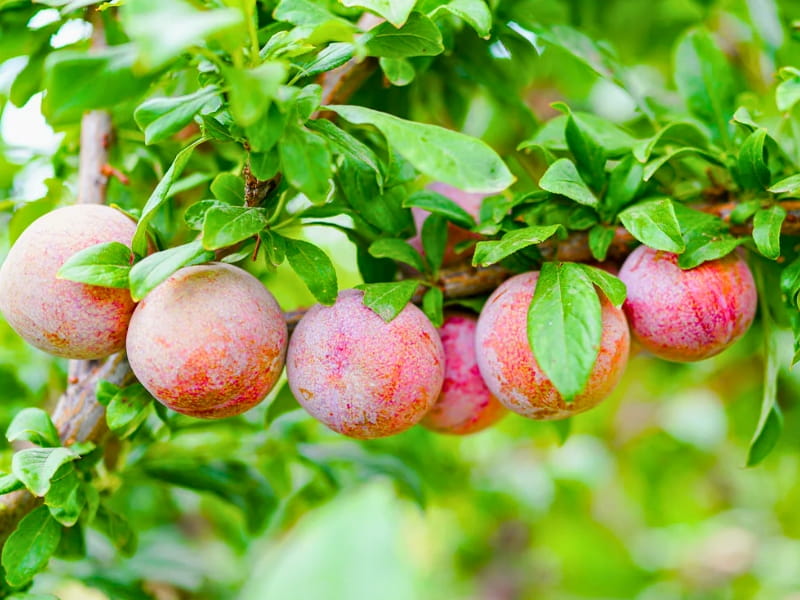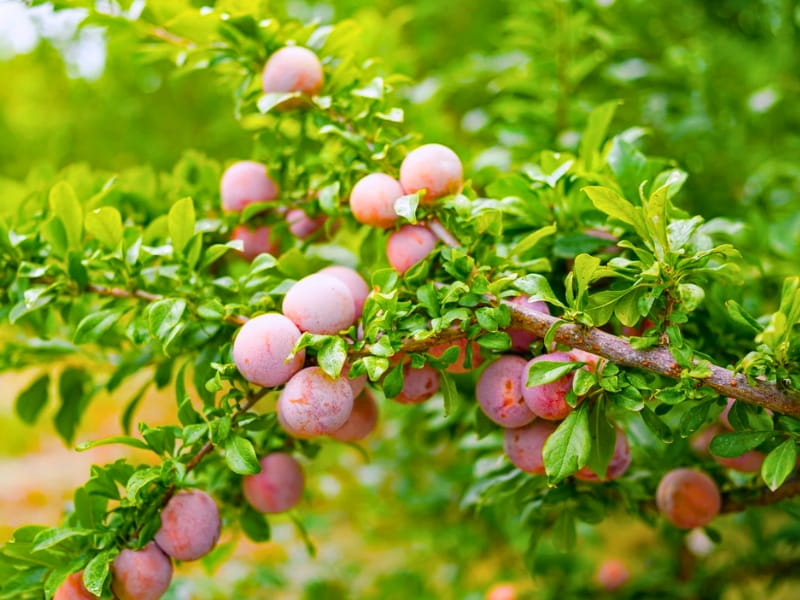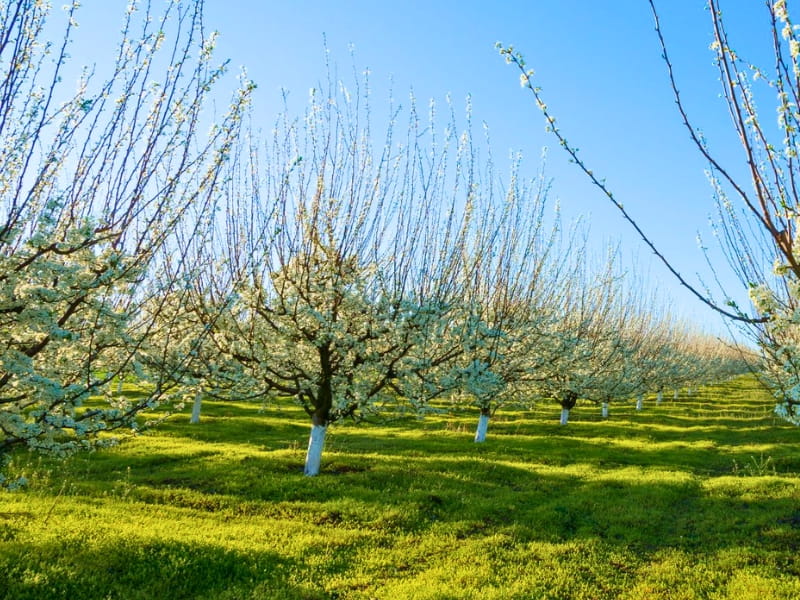The Flavor King Pluot tree, also known as the Pluot ‘Flavor King’, Prunus salicina x armeniaca ‘Flavor King’, and sometimes simply “King Pluot,” is a truly remarkable fruit-bearing tree. This interspecific hybrid, a cross between a plum and an apricot, delivers an unparalleled flavor sensation that consistently ranks it among the most sought-after stone fruits.
This comprehensive guide will cover everything from the tree’s unique characteristics and growing requirements to tips on selecting the best Flavor King Pluot tree for your needs, and even comparing it to other pluot varieties. Let’s start by helping you buy a Flavor King Pluot Tree.

Understanding the Flavor King Pluot: A Royal Treat for Your Garden
The Flavor King Pluot is not just another fruit tree; it’s a culinary experience. Its vibrant reddish-purple skin hints at the sweet, juicy, and intensely flavored flesh within. The taste is often described as a complex blend of plum and apricot, with notes of cherry and even a hint of spice. Unlike some plums, the Flavor King has a pleasingly firm texture that holds up well even when fully ripe. This makes it perfect for fresh eating, salads, baking, and even grilling.
| Common name | Flavor King Pluot, King Pluot |
| Botanical name | Prunus salicina x armeniaca ‘Flavor King’ |
| Synonym | Pluot ‘Flavor King’ |
| Family | Rosaceae |
| Genus | Prunus |
| Species | salicina x armeniaca (Hybrid) |
| Origin | California, USA |
| Native | Developed in California, adaptable to various regions. |
| Life cycle | Perennial |
| Plant type | Fruit Tree, Deciduous Tree |
| Hardiness zone | Typically 6-9, possibly 5 with protection |
| Sunlight | Full Sun (6-8 hours minimum) |
| Maintenance | Moderate |
| Water | Moderate, regular deep watering |
| Drainage | Well-Drained |
| Soil pH | 6.0-7.0 (Slightly Acidic to Neutral) |
| Spacing | 12-18 ft. (depending on rootstock) |
| Flowering period | Spring (White or light pink blossoms) |
| Harvest period | Mid to Late Summer (July-August) |
| Height | 12-18 ft. at maturity (depending on rootstock) |
| Width | 12-18 ft. at maturity (depending on rootstock) |
| Growth rate | Moderate to Fast |
| Fruit color | Deep Red-Purple Skin, Yellow-Orange Flesh |
| Flower color | White or Light Pink |
| Flower benefit | Attracts pollinators, beautiful spring display. |
| Fruit Benefit | Exceptional flavor, versatile uses. |
| Garden style | Orchard, Home Garden, Edible Landscape |
| Uses | Fresh eating, baking, salads, preserves, grilling |
| Chill Hours | 400-500 |
| Pollination | Requires cross-pollination (e.g., Santa Rosa Plum, Flavor Queen Pluot) |
| Disease Resistance | Relatively good resistance to common stone fruit diseases. |
| Rootstock | Varies (Commonly Citation, Myrobalan 29C, Lovell |
The Flavor King’s origins trace back to the innovative work of Floyd Zaiger, a renowned fruit breeder in California. Zaiger Genetics is famous for developing many popular stone fruit varieties, and the Flavor King is considered one of their crowning achievements. It’s a testament to their dedication to creating fruits with exceptional flavor and texture.
Let’s explore some key characteristics that make this tree so special:
- Appearance: The tree itself is a moderately vigorous grower, typically reaching a height of 12-18 feet at maturity, depending on the rootstock and growing conditions. The leaves are a vibrant green, and the tree produces beautiful white or light pink blossoms in the spring, adding an ornamental touch to your landscape. The fruit is medium to large, with a rounded shape and that signature deep red-purple skin.
- Flavor Profile: As mentioned, the flavor is the star of the show. It’s intensely sweet, with a balanced acidity that prevents it from being cloying. The rich, complex flavor develops fully as the fruit ripens on the tree, making it crucial to harvest at the right time.
- Chill Hours: This is a critical factor for successful fruit production. Flavor King Pluot trees require a certain number of chill hours, which are hours below 45°F (7°C) during the dormant season. The Flavor King typically needs between 400-500 chill hours. This makes it suitable for many regions, but it’s essential to verify that your local climate provides enough chill hours before planting. We’ll delve deeper into this later.
- Pollination: While some pluot varieties are self-pollinating, the Flavor King requires a pollinator. This means you’ll need to plant another compatible plum or pluot variety nearby to ensure fruit set. Good pollinators for Flavor King include:
- Santa Rosa Plum
- Flavor Queen Pluot
- Flavor Grenade Pluot
- Dapple Dandy Pluot
- Harvest Time: Flavor King Pluots typically ripen in mid to late summer, usually from July to August, depending on your location and climate. The exact timing can vary slightly from year to year, so it’s important to monitor the fruit closely for signs of ripeness.
- Disease Resistance: While no tree is entirely immune to diseases, the Flavor King Pluot shows relatively good resistance to common stone fruit diseases, such as bacterial canker and brown rot. However, preventative measures and good orchard management practices are still essential.
Why Choose a Flavor King Pluot Tree? (A Summary of Benefits)
| Benefit | Description |
| Exceptional Flavor | Unmatched sweetness, complexity, and a perfect balance of plum and apricot notes. |
| Beautiful Tree | Attractive foliage and blossoms add ornamental value to your garden. |
| Versatile Fruit | Delicious fresh, in salads, baked goods, or grilled. |
| Good Disease Resistance | Relatively resistant to common stone fruit diseases, making it easier to manage. |
| Rewarding to Grow | The satisfaction of harvesting your own homegrown, premium-quality fruit. |
| High-Quality | The fruits has a pleasingly firm texture that remains even when fully ripe |

This section provides a solid foundation for understanding the Flavor King Pluot. It addresses the informational search intent, highlighting key characteristics and benefits. The table format enhances readability and SEO. The mention of Floyd Zaiger and Zaiger Genetics adds authority (E-E-A-T). The inclusion of chill hours, pollination, and harvest time are crucial for successful growing and cater to user expectations.
Growing a Flavor King Pluot Tree: A Step-by-Step Guide
Planting and nurturing a Flavor King Pluot tree is a rewarding experience. With proper care, you can enjoy bountiful harvests of this delicious fruit for years to come. Gardencenterpoint is here to guide you every step of the way.
1. Choosing the Right Location:
- Sunlight: Pluot trees thrive in full sun, requiring at least 6-8 hours of direct sunlight per day. More sunlight generally leads to better fruit production and flavor development.
- Soil: Well-drained soil is crucial. Pluots do not tolerate waterlogged conditions. The ideal soil pH is between 6.0 and 7.0, slightly acidic to neutral. Amend heavy clay soils with compost or other organic matter to improve drainage. A soil test can help you determine your soil’s pH and nutrient levels.
- Space: Consider the mature size of the tree (12-18 feet tall and wide, depending on rootstock). Allow ample space for the tree to grow without overcrowding.
- Climate: Ensure your region provides the necessary chill hours (400-500 for Flavor King). Check your local climate data or consult with your local extension office.
- Protection from Wind: Strong winds can damage blossoms and young fruit. If your area is prone to high winds, consider planting the tree in a sheltered location or providing a windbreak.
2. Selecting Your Tree:
- Bare-Root vs. Container-Grown: Bare-root trees are typically available in the winter and early spring, while container-grown trees are available year-round. Both can be successful, but bare-root trees often establish faster.
- Rootstock: The rootstock influences the tree’s size, disease resistance, and soil adaptability. Common rootstocks for pluots include Citation, Myrobalan 29C, and Lovell. Discuss rootstock options with the nursery to determine the best choice for your needs.
- Tree Health: Inspect the tree carefully for any signs of damage, disease, or pests. Choose a tree with a strong, straight trunk and healthy branches.
3. Planting Your Flavor King Pluot Tree:
- Timing: Plant bare-root trees in late winter or early spring, while the tree is still dormant. Container-grown trees can be planted any time of year, as long as the ground is not frozen.
- Digging the Hole: Dig a hole that is twice as wide as the root ball and just as deep.
- Preparing the Roots: Gently loosen any circling roots on container-grown trees. For bare-root trees, soak the roots in water for a few hours before planting.
- Planting: Place the tree in the hole, ensuring that the top of the root ball is level with the surrounding soil. Backfill the hole with the native soil, gently firming it around the roots.
- Watering: Water the tree deeply after planting to settle the soil and eliminate air pockets.
4. Ongoing Care:
- Watering: Provide regular, deep watering, especially during dry periods. The amount of water needed will depend on your climate, soil type, and the tree’s age. A general guideline is to water deeply when the top few inches of soil feel dry.
- Fertilizing: Pluot trees benefit from regular fertilization. Apply a balanced fertilizer in early spring, following the manufacturer’s instructions. A soil test can help you determine the specific nutrient needs of your tree.
- Pruning: Pruning is essential for maintaining the tree’s shape, promoting fruit production, and improving air circulation. Prune during the dormant season (late winter or early spring). Remove any dead, damaged, or crossing branches. Thin out crowded branches to allow sunlight to reach the center of the tree.
- Pest and Disease Control: Monitor the tree regularly for signs of pests or diseases. Implement preventative measures, such as applying dormant oil spray in the winter to control overwintering pests. If problems arise, identify the specific pest or disease and use appropriate control methods. Integrated Pest Management (IPM) strategies are recommended to minimize the use of pesticides.
- Thinning Fruit: Thinning young fruit is crucial for producing larger, higher-quality pluots. When the fruit is about the size of a dime, remove excess fruit, leaving about 4-6 inches between each remaining fruit. This allows the remaining fruit to develop fully and improves air circulation, reducing the risk of disease.
5. Harvesting Your Delicious Pluots:
- Ripeness Indicators: Flavor King Pluots are ready to harvest when they reach their full color (deep red-purple) and yield slightly to gentle pressure. The fruit should also have a sweet, fragrant aroma.
- Harvesting Technique: Gently twist the fruit from the branch, being careful not to damage the spur (the small branch that produces fruit).
- Storage: Ripe pluots can be stored in the refrigerator for up to a week. For longer storage, you can freeze or can them.
This section provides a detailed, step-by-step guide that addresses the “how-to” aspect of the informational search intent. It includes specific details on sunlight, soil, watering, fertilizing, pruning, pest control, and harvesting, making it practical and actionable for readers. The use of bullet points and numbered steps enhances readability and SEO.
Comparing Flavor King to Other Pluot Varieties: Finding Your Perfect Fit
While the Flavor King is a standout variety, it’s helpful to understand how it compares to other popular pluots. This will help you make an informed decision based on your preferences and growing conditions. This section addresses the informational/comparison search intent.
Here’s a comparison table:
| Pluot Variety | Flavor Profile | Chill Hours | Pollinator Required | Skin Color | Flesh Color | Harvest Time | Notes |
| Flavor King | Intensely sweet, complex, plum-apricot blend | 400-500 | Yes | Deep Red-Purple | Yellow-Orange | Mid-Late Summer | Considered the benchmark for pluot flavor. |
| Flavor Queen | Very sweet, slightly less complex than Flavor King | 400-500 | Yes | Greenish-Yellow | Yellow | Mid-Summer | Good pollinator for Flavor King. |
| Flavor Grenade | Sweet, crisp, with a slight tang | 200-300 | Yes | Greenish-Yellow with Red Blush | Yellow | Late Summer | Excellent for warmer climates with low chill hours. Stores well. |
| Dapple Dandy | Sweet, mild flavor | 400-500 | Yes | Mottled Green-Red | Pink | Mid-Summer | Good pollinator for Flavor King. Known for its beautiful mottled skin. |
| Flavor Supreme | Sweet and tart | 200-300 | Yes | Green | Red | Early Summer | High-quality early season fruit. |

Key Considerations When Choosing a Pluot Variety:
- Chill Hours: This is the most critical factor. Choose a variety that is well-suited to your local climate.
- Flavor Preference: Do you prefer intensely sweet fruit, or something with a bit more tang?
- Pollination Needs: Ensure you have a compatible pollinator if the variety requires one.
- Harvest Time: Consider when you want to harvest your fruit. Different varieties ripen at different times.
- Disease Resistance: Some varieties may be more resistant to certain diseases than others.
A Deeper Dive into Pollination A 2023 study by the University of California, Davis, emphasized the importance of proper pollination for optimal fruit set in pluot trees. The study found that cross-pollination with a compatible variety significantly increased fruit yield and size compared to self-pollination (even in varieties considered partially self-fruitful). The research highlighted the role of bees and other pollinators in transferring pollen between trees, underscoring the need for a healthy pollinator population in your garden or orchard. This can include various species like Santa Rosa Plum, Flavor Queen Pluot, Flavor Grenade Pluot, and Dapple Dandy Pluot.
This section provides a clear comparison of different pluot varieties, addressing the comparison search intent. The table format is highly effective for presenting this type of information. The inclusion of a scientific study adds credibility (E-E-A-T) and provides valuable, up-to-date information.
Troubleshooting Common Flavor King Pluot Tree Problems
Even with the best care, you may encounter some challenges when growing a Flavor King Pluot tree. Here are some common problems and their solutions:
- Lack of Fruit:
- Insufficient Chill Hours: If your climate doesn’t provide enough chill hours, the tree may not produce fruit.
- Poor Pollination: Ensure you have a compatible pollinator planted nearby.
- Late Frost: A late frost can damage blossoms, preventing fruit set.
- Nutrient Deficiency: A soil test can help identify any nutrient deficiencies.
- Over-Pruning/Incorrect: Too much pruning can affect fruit production.
- Small or Misshapen Fruit:
- Inadequate Thinning: Thinning young fruit is crucial for producing larger, higher-quality pluots.
- Poor Pollination: Incomplete pollination can result in misshapen fruit.
- Water Stress: Insufficient or inconsistent watering can affect fruit size and quality.
- Pest and Disease Issues:
- Aphids: These small, sap-sucking insects can distort leaves and fruit. Control them with insecticidal soap or neem oil.
- Brown Rot: This fungal disease causes brown spots on fruit and blossoms. Prevent it with good air circulation, proper pruning, and fungicidal sprays if necessary.
- Bacterial Canker: This bacterial disease causes sunken lesions on branches and can eventually kill the tree. Prune out infected branches and apply a copper-based fungicide.
- Peach Tree Borer: These insects bore into the trunk and branches, weakening the tree. Prevent them with pheromone traps and insecticide applications if necessary.
Proactive Measures for a Healthy Tree:
- Regular Monitoring: Inspect your tree regularly for any signs of problems.
- Good Sanitation: Remove fallen leaves and fruit to reduce the risk of disease.
- Proper Watering and Fertilizing: Provide consistent care to keep the tree healthy and stress-free.
- Preventative Treatments: Apply dormant oil spray in the winter to control overwintering pests.
This section addresses potential problems and provides practical solutions, fulfilling a key aspect of the informational search intent. It reinforces the importance of proactive care and preventative measures.

Leave a Reply